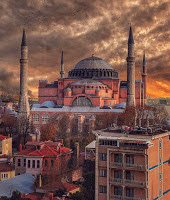What is Hagia Sophia (Turkish Ayasofya)? Is it a Church or is it a Mosque?
Well, the answer would change depending on whom you ask the question.
So, let us look into the history of this magnificent building that houses the largest dome in the world.
Hagia Sophia's complex history began in the year 537 when Byzantine emperor Justinian built the huge church overlooking the Golden Horn harbor. With its huge dome, it was believed to be the world's largest church and building.
It remained in Byzantine hands for centuries apart from a brief moment in 1204 when Crusaders raided the city.
In 1453, in a devastating blow to the Byzantines, Ottoman Sultan Mehmed II captured Istanbul (formerly known as Constantinople), and the victorious conqueror performed Friday prayers inside Hagia Sophia.
The Ottomans soon converted the building into a mosque, adding four minarets to the exterior and covering ornate Christian icons and gold mosaics with panels of Arabic religious calligraphy.
After centuries at the heart of the Muslim Ottoman empire, it was turned into a museum in 1934 in a drive to make Turkey more secular.
Since then it has been open to visitors, attracting more than 3.7 million visitors a year.
But the world outside fears that this is about to change as a high Court in Turkey ruled to overturn the 1934 decision of converting the building into a museum. On 10th July 2020, the Turkish President Erdogan announced that Hagia Sophia will be converted into a mosque and will soon be opened for prayer.
The move has been faced with backlash from the Russian Orthodox Church and the neighboring Greece, who have urged Turkey to reverse the decision to convert the building into a Mosque.
Also Read How is the Hajj pilgrimage different in 2020?
In their defense, the Turkish officials said that the site would still be open for visits by tourists of all faiths even after it ceases to exist as a museum.
Turkey insists that the official status of the monument is an internal affair. But for many people across the globe, Hagia Sophia was a symbol of a secular Turkey that was built in the values, Mustafa Kemal Ataturk.
Turkey insists that the official status of the monument is an internal affair. But for many people across the globe, Hagia Sophia was the symbol of a secular Turkish state which was built on the values, Mustafa Kemal Ataturk. The move threatened to violate this fine balance that has existed between the communities for decades and thus it remains to be seen what's in store next for this magnificent piece of architecture that has stood the test of time, at least as a building.

![Emperor Justinian Justinian I, Latin in full Flavius Justinianus, original name Petrus Sabbatius, (born 483, Tauresium, Dardania [probably near modern Skopje, North Macedonia]—died November 14, 565, Constantinople [now Istanbul, Turkey]), Byzantine emperor (527–565), noted for his administrative reorganization of the imperial government and for his sponsorship of a codification of laws known as the Code of Justinian (Codex Justinianus; 534). Hagia Sophia's complex history began in the year 537 when Byzantine emperor Justinian built the huge church overlooking the Golden Horn harbor](https://blogger.googleusercontent.com/img/b/R29vZ2xl/AVvXsEjz_vjnTozbmIJ3eGIU9HAWgpwyfc_05qhKJqL3kpp8AWqkiwMiAVfu5gI6usfPch6HvS_kddxy2pldWHZp5dWmCfCFbrXnkyY6Xb3G7lwoiQ58Yv5I6CEjv-GzNZcvLvoQKzwCeQd8ZJME/w190-h256/WhatsApp+Image+2020-07-12+at+15.05.50.jpeg)

